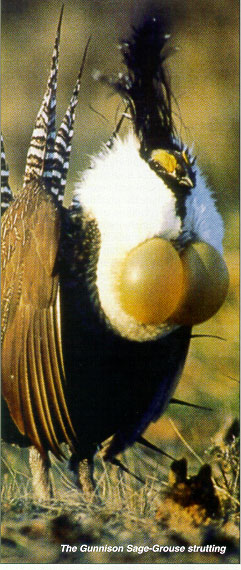State biologists are inviting the public to view the strutting display of Gunnison sage-grouse on the weekends of March 29 and 30 and April 12 and 13.
Small groups limited to 15 people will be able to see the Gunnison sage-grouse strut on their breeding grounds known as leks, east of Monticello.
Utah is home to two sage-grouse species: the greater sage-grouse and the Gunnison sage-grouse.
The Gunnison sage-grouse is the rarer of the two.
At 7 p.m. on the Friday evening of each weekend, March 29 and April 12, an orientation will be held in the commission chambers of the San Juan County Building, 117 South Main in Monticello.
The orientations and presentation will be provided by Guy Wallace, a wildlife biologist with the Division of Wildlife Resources. He will share information about the ecology, life history, geographic distribution and legal status of Gunnison sage-grouse. He will also share information about where and when to meet the following morning.
The best viewing always occurs just before dawn or right at dawn. Within an hour after sunrise, grouse are usually done strutting.
Those planning to attend should wear layers and prepare for winter-like conditions. It is strongly suggested to bring a camera and a pair of binoculars or a spotting scope. Division of Wildlife Resources biologists will also have extra binoculars and spotting scopes you can use.
To lessen the chance of disturbing the birds, participants are encouraged to carpool to the lek with other participants. The trip from Monticello to the strutting ground will take about an hour.
According to the Bureau of Land Management, Gunnison sage-grouse have declined in number over the past century because of the loss of sagebrush habitats essential for their survival.
The greater sage-grouse and the Gunnison sage-grouse look and behave similarly, live in sagebrush and display in leks, but there are some distinct differences.
The Gunnison sage-grouse are about 2/3 the size of greater sage-grouse, they make different sounds, and the males have bigger featers on top of their heads that they flip around while displaying on a lek.
While both the greater and the Gunnison sage-grouse are rare, the Gunnison sage-grouse population is much smaller with only about 3,500 individuals alive today. Almost all of the remaining Gunnison sage-grouse are found in Colorado, with a few found south of Moab. Greater sage-grouse, on the other hand, live in 11 western states and Canada.
Researchers believe there are probably between 200,000 and 500,000 greater sage-grouse living now. Both species are candidates for listing under the Endangered Species Act.




